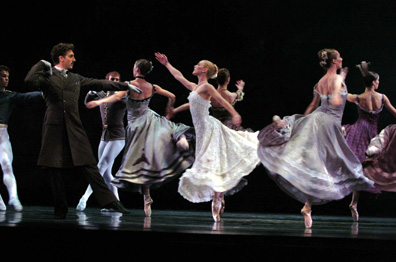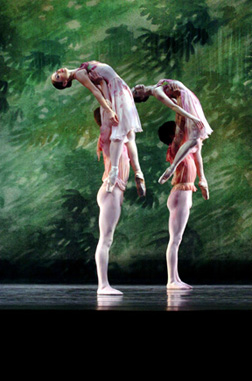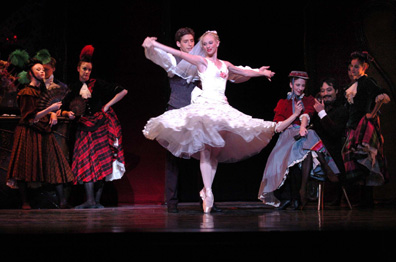Britain’s neglected creator
Antony Tudor choreography
“The Leaves are Fading”/“Lilac Garden”/“Offenbach
in the Underworld”
Ballet West
The Edinburgh Playhouse
August 27 – 30, 2004
Mahler and Dance
“Dark Elegies”
Rambert Dance Company
The Edinburgh Playhouse
September 2 – 4, 2004
By
John Percival
copyright
© 2004 by John
Percival
published October 4, 2004
The two great choreographers produced by British ballet have both been neglected here lately. Luckily, Frederick Ashton’s centenary is compelling his restoration to the repertoire, and—presumably by coincidence—this year’s Edinburgh Festival chose his near contemporary and rival Antony Tudor for special attention. Of course they had to look overseas for the main contribution. The choice fell on Ballet West, all the way from Salt Lake City, Utah (a city, amazingly, doubly represented in the Festival’s dance programmes, thanks to an Alwin Nikolais bill by its Ririe-Woodbury Dance Company).

You remember the situation? Caroline, before a marriage of convenience, tries to say goodbye to her real lover; meanwhile the man she must marry shrugs off an importunate episode from his own past. The way Tudor set, and sometimes contrasted, the Chausson music (“Poème”) is well established, bringing out the individuality of the principals and sometimes the other party-goers too, especially the one identifiable as Caroline’s sister. Ballet West’s two casts both expressed the theme well without greatly illuminating it. I miss the original designs of Hugh Stevenson (who also helped define the ballet’s action) but I seem to remember that trade union restrictions kept American productions from using them, and Peter Cazalet’s replacements are not too far removed.

The programme’s big rarity, “Offenbach in the Underworld”, is new to the company, and I wonder who thought of producing this middle-period piece (created for the Philadelphia Ballet, 1954, although the present version was a revision the next year for the Canadian Ballet). Edinburgh commissioned the revival, excellently staged by Donald Mahler.
Tudor originally used the highly popular score adapted by Manuel Rosenthal from an Offenbach operetta for Leonide Massine’s “Gaité parisienne”, but the Canadian conductor George Crum made an equally attractive new arrangement for the revised production. Tudor’s ballet, like Massine’s, offers episodes of flirtation between characters in a late 19th century café (although Yenichi Yamaguchi’s setting makes it look more like the long lost “Bar aux Folies-bergère” by Ninette de Valois). Tudor doesn’t introduce such distinctive characters as Massine did, but his treatment holds together better as a continuing whole, and his long sequence of can-can dances provides a rowdier climax.

At first sight, “Offenbach in the Underworld” can seem a slight although amusing ballet. But I watched three performances in two days and it came over more strongly each time. The author of the Festival’s programme note about Tudor’s Unique Dance Legacy must have been off form when he came up with the theory that Tudor lost his creativity after 1943. I will insist that two of the works on this programme prove him wrong, and I can think of plenty of other late Tudors I would like to see again (or even a couple for the first time). Meanwhile I am grateful to the Festival and to Ballet West for remedying our Tudor starvation.
%20Catherine%20Ashmore.jpg) Less
so, however, for the Festival’s other Tudor production, “Dark
Elegies”, given by Rambert Dance Company as part of a triple bill,
“Mahler and Dance”, presenting—uniquely—three
of that composer’s song cycles in dance form. Their new “Songs
of a Wayfarer” by Kim Brandstrup seemed pointless to me, and Peter
Darrell’s “Five Ruckert Songs”, a Rambert premiere,
has been better danced and in better designs by its originator, Scottish
Ballet. So “Elegies”, created for Rambert in 1937, should
have been a climax, with its tragic representation of families who lost
their children in some disaster.
Less
so, however, for the Festival’s other Tudor production, “Dark
Elegies”, given by Rambert Dance Company as part of a triple bill,
“Mahler and Dance”, presenting—uniquely—three
of that composer’s song cycles in dance form. Their new “Songs
of a Wayfarer” by Kim Brandstrup seemed pointless to me, and Peter
Darrell’s “Five Ruckert Songs”, a Rambert premiere,
has been better danced and in better designs by its originator, Scottish
Ballet. So “Elegies”, created for Rambert in 1937, should
have been a climax, with its tragic representation of families who lost
their children in some disaster.
After past legal disputes, Rambert presents its own version of the work, based on the memories, notes and films of earlier casts. This differs from the Tudor estate’s authorised version based on his 1940 staging for Ballet Theatre. Rambert claims that it is “determined to keep its production close to the original” created for the company. Fine, but in that case my memory, and that of others, suggests a need for less obfuscatory lighting and for the movement to be less swift and light. None of the present company dancers, I think, has previous experience of Tudor, and it shows. More work could doubtless help—but ludicrously the ballet is not scheduled for any further performances.
Photo credits:
First: Ballet West's Christopher Rudd & Kristin Hakala (centre)
& Ensemble in Antony Tudor’s "Lilac Garden." Photo:
Douglas Robertson.
Second: (Right)Michael Bearden & Annie Breneman, (left) Hua Zhuang
& Christiana Bennett in "The Leaves are Fading." Photo:
Douglas Robertson.
Third: Alison Harvey & Michael Bearden in "Offenbach in
the Underworld." Photo: Douglas Robertson.
Fourth: A photo from Ballet Rambert's 1988 production of "Dark
Elegies." Photo: Catherine Ashmore.
www.danceviewtimes.com
Volume 2, No. 37
October 4, 2004
Copyright
©2004 by John Percival
|
|
|